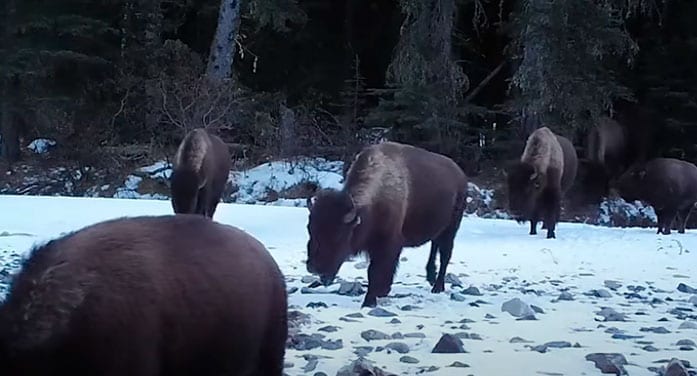A project conceived to rebuild a long-lost bison herd in Banff National Park is not only healing the land, according to a pair of University of Alberta undergraduate researchers, but has created a framework for reconciliation and decolonization to follow moving forward.
What started out as a literature review of the Bison Belong Project soon revealed itself as a healing exercise for undergraduate students Regan Wright and Katja Schreiner, who titled the project Medicine That Walks, as part of Faculty of Kinesiology, Sport, and Recreation professor PearlAnn Reichwein’s KRLS 323 course a year ago.
“Once we realized how important bison are to plains Indigenous people, the more we wanted to see if we could link the bison to not only the health of the land but to the health of the people,” said Wright.
The Bison Belong Project in question saw 10 pregnant cows and a handful of bulls from Elk Island National Park released into Banff’s Panther Valley in early 2017 as part of a Parks Canada collaborative initiative to reintroduce bison into the area for the first time since the beasts were extirpated in the 1870s.
From an ecological standpoint, the massive herds of bison once played a pivotal role in revitalizing the plains. Their manure and urine supply nutrients for the plant cover, while their hooves help to bury seeds and to create small pockets in the ground that capture moisture. Even many prairie potholes and small ponds, which teem with life, began as buffalo wallows.
“The Bison Belong Project certainly can be a model for fixing problems within the ecological chain, but also a model to heal not just Indigenous people but to heal the relationship between Indigenous and non-Indigenous Canadians,” said Schreiner.
The team benefited from a visit from Elder Elsey Gauthier, an adviser at the U of A’s First Peoples’ House, who was invited to speak about the importance of balance and the medicine wheel, an Indigenous model for health that goes beyond the western sense of physical health to include emotional, mental and spiritual well-being.
Wright said the pair used the medicine wheel to build a list of what has been lost with the absence of the bison. That list includes access to sacred items (spiritual), education and knowledge on the importance of bison as ecological engineers (mental), a relationship with their bison kin (emotional) and a key piece of their traditional diet (physical).
“For more than 100 years now, bison have been gone from this area of Alberta,” said Wright. “How do we start building that kinship relationship back up again?”
The team then began looking at recommendations contained in the Truth and Reconciliation Commission report, as well as the United Nations Declaration on the Rights of Indigenous Peoples to ask how an ecological restoration project can target the larger question of healing.
Even before the bison were reintroduced, Wright said the project set a standard for consultation.
“The fact that this project did a good job of that is also really important in terms of the TRC. A big part of the calls to action is allowing Indigenous peoples the space to be consulted on things that concern their lands,” said Wright.
Schreiner, who carried on with the project with Reichwein last summer, added that one of the promising things that have already happened is that Indigenous people are also reconnecting to the area. For instance, the Nakoda A/V Club was invited into the Panther Valley and created films on their experiences with the bison that were shared at the Banff Mountain Film Festival. As well, a group of Indigenous women made a trek to Banff to see the bison, with one participant noting, “(The bison) are my relatives, my cousins, they are what connect me to my ancestors. It was almost sacred seeing them.”
“Consultation is great, but how do we really entrench Indigenous epistemologies and ways of knowing into these projects from the beginning and go beyond just consultation?” said Schreiner. “I think it’s a good start, but I think that’s one way that it can be pushed further.”
They said acknowledging that bison were affected by colonialism and recognizing Indigenous kinship with them can work to decolonize environmental stewardship, and shift the focus from duty to connection.
In their report, Wright and Schreiner noted that “the return of a species representing much of Indigenous sovereignty to its traditional space, also fostering kinship connections via interaction, is an act of decolonization.”
“We believe the Bison Belong Project can be used as a standard for how we treat national parks and how we move forward, blending the best of western knowledge as well as Indigenous knowledge,” said Schreiner.
Wright, a medical student at the U of A, and Schreiner, who is doing a certificate in Indigenous sport and recreation with the hope of one day entering a career in physical therapy, said they have been affected significantly by the project.
“Even though I’m not Indigenous, this has had a profound impact on the way I view the land,” said Wright. “Just seeing how it can affect people so emotionally and spiritually.”
| By Michael Brown for Troy Media
This article first appeared in Folio, published by the University of Alberta. Folio is a Troy Media![]() Editorial Content Provider Partner.
Editorial Content Provider Partner.
COMMUNITY NEWS OUTLET ACTION PLAN!
WEBSITE HOSTING AND ALL TROY MEDIA EDITORIAL CONTENT POSTED TO YOUR SITE DAILY FOR ONLY $129.95 PER MONTH.
Limited time offer: Get your first 2 months FREE! Click here for details
